Expert Tips for Choosing the Right Wetsuit Shoes
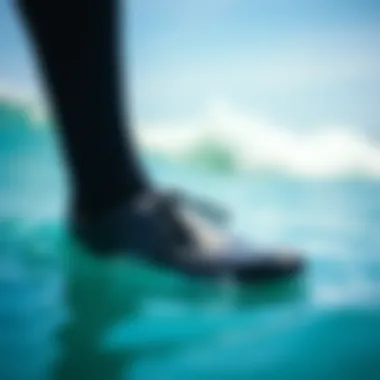
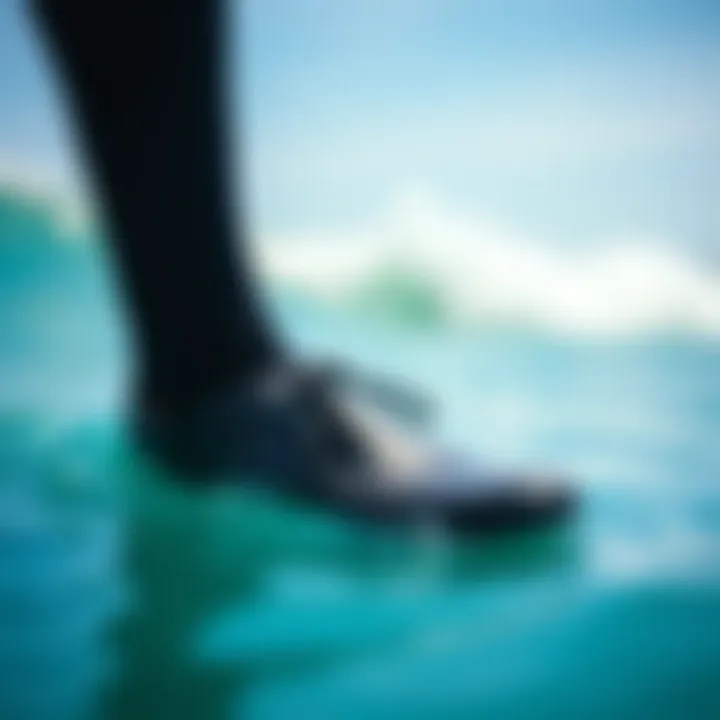
Intro
Selecting the right pair of wetsuit shoes is not just a matter of comfort; it’s a crucial decision that can greatly influence your overall experience on the water. For enthusiasts of watersports, be it surfing, paddleboarding, or kitesurfing, the appropriate footwear offers protection, warmth, and flexibility. Imagine yourself navigating through the waves, feeling at one with the ocean while also keeping your feet insulated from cold water and sharp rocks. This practical guide aims to shed light on the essential aspects of choosing wetsuit shoes and why each detail matters.
Many novices and seasoned surfers alike can find themselves at a loss when faced with so many options in today's market. Not all wetsuit shoes are created equal; different activities call for different features. Factors such as material composition, fit, durability, and purpose come into play, making it imperative to understand what you need. In this guide, we’ll dissect these elements to ensure that when you hit the water, it’s nothing short of exhilarating.
We'll also dive into top picks available from renowned brands and provide maintenance tips to keep your gear in shape for the long haul. After all, treating your equipment well translates to enhanced performance out in the most challenging conditions.
As we navigate through this comprehensive guide, be prepared to learn motivations that will not only heighten your enjoyment but also safeguard your feet in any watersport adventure.
Preamble to Wetsuit Shoes
Wetsuit shoes serve a vital role in enhancing comfort and performance during various water activities. For surfers, paddleboarders, and kitesurfers alike, these specialized footwear options can mean the difference between an enjoyable outing and an uncomfortable experience. It’s essential to recognize that while wetsuit shoes may appear as just another piece of gear, their impact on safety, warmth, and grip can be immense.
The core function of these shoes is to provide insulation and protection for the feet when dealing with cold water temperatures. Without proper footwear, you can quickly find yourself battling numb toes and altered balance, which can lead to stumbles or falls. Just imagine standing on a surfboard, trying to catch a wave, while your feet feel like ice blocks. Not particularly ideal, is it?
Footwear designed for wetsuits also offers traction on wet surfaces, be it a rocky shoreline or waterlogged decks of paddleboards. This grip allows for a stable footing, which is critical whether you’re launching into the ocean or adjusting your stance mid-ride. Think of it as having a good pair of tires on your car; they help you maneuver safely under varying conditions.
Moreover, many people tend to overlook the need for protection against unpredictable elements. Sharp rocks, shells, or marine life can wreak havoc on unprotected feet. With proper wetsuit shoes, not only do you get insulation but also a safeguard against potential hazards.
In this guide, we will closely examine the various components that make a wetsuit shoe effective, factors to consider when selecting the right pair, and explore some of the top brands and products out there. This detailed look into the world of wetsuit shoes ensures that you have all the information needed to make an informed choice tailored precisely to your watersport activities.
Consider this your go-to manual, guiding you through the myriad aspects involved in selecting the best wetsuit shoes that fit your lifestyle, so that you can enjoy every dip, every wave, and every moment spent on the water.
Understanding Wetsuit Shoe Functionality
When you're gearing up for your next watersport adventure, the functionality of your wetsuit shoes can make or break your experience. These specialized footwear items are not just an afterthought; they play a pivotal role in enhancing your performance, safety, and comfort on the water. Understanding how these shoes work can help you make an informed choice that aligns with your specific activities, whether it's surfing, paddleboarding, or kitesurfing.
Role of Insulation
Insulation is perhaps the unsung hero of wetsuit shoe functionality. The main goal here is to keep your feet warm, especially in colder waters. Neoprene, the primary material used for these shoes, excels at retaining heat. It creates a barrier between your skin and the water, minimizing heat loss. The thickness of the neoprene can vary, typically ranging from 2mm to 7mm, depending on your needs.
If you're venturing into chilly conditions, a thicker design is essential. Remember, having cold feet can turn a great day on the water into a miserable experience. For those winter surf sessions, consider choosing a model that specifies thermal lining—this not only helps in insulation but can also wick away moisture, keeping your feet comfortable. The added warmth allows for prolonged enjoyment and performance.
Importance of Traction
Anyone who's ever paddled out to catch a wave can attest to the importance of traction in wetsuit shoes. Slippery surfaces on rocks or wet boards can result in slips that could hurt you or spoil your vibe. Proper grip is paramount, especially during those intense moments on the water.
Quality wetsuit shoes come with specially designed rubber outsoles built to provide that essential traction. Look for shoes that feature specific tread patterns; these aren't just for show. A well-designed outsole ensures that you can stand firmly whether you're navigating a rocky shoreline or securing your stance on the board. This feature isn't just about comfort but serves as a key safety measure.
Protection Against Elements
Wetsuit shoes offer more than just warmth; they provide crucial protection against the elements. From sharp rocks to potential marine life, your feet are often at risk of injury when exposed. With the right pair of wetsuit shoes, you're equipping yourself with a shield.
Quality footwear will help fend off cuts, scrapes, and other injuries that can mar your fun in the sun. Look for features like reinforced toe caps and sturdy materials that can withstand rough treatment. Additionally, many modern designs offer some level of water resistance, further decreasing the annoyance of getting soggy shoes in the first place. This added layer of protection contributes significantly to overall enjoyment and can boost your confidence on the water.
"Choosing the right wetsuit shoes is often the difference between an enjoyable day in the waves and a regrettable experience that leaves you feeling like you’ve stuck your toes in icy daggers."
In summary, understanding the functionality of your wetsuit shoes is crucial for any watersport enthusiast. From insulation to traction and protection, each aspect plays a significant role in ensuring that your time on the water is safe and enjoyable. Make these considerations a priority to enhance not only your performance but also your overall experience in the water.
Key Materials Used in Wetsuit Shoes
The materials used in wetsuit shoes play a crucial role in both their performance and durability. Understanding these materials is essential for making an informed choice, whether you are a seasoned surfer or just starting with paddleboarding. High-quality wetsuit shoes offer not just comfort, but also protection against the chilled waters and rugged terrains often encountered in watersports. Let’s delve into the primary materials that make these shoes stand out.
Neoprene Properties
Neoprene serves as a cornerstone material in the construction of wetsuit shoes. Its insulating properties are pivotal, keeping your feet warm during prolonged exposure to cold water.
- Water Resistance: Neoprene itself is impermeable, meaning it does not allow water to seep in easily. This feature is vital for any watersport; wet feet can quickly sap your energy and enjoyment.
- Flexibility and Comfort: Neoprene is inherently flexible, molding closely to the foot's shape. This snug fit provides excellent comfort, enabling natural movement while engaging in various activities.
- Durability: Over time, neoprene has proven its resilience against wear and tear. It holds up against the rigorous demands of saltwater and doesn’t easily degrade under sun exposure.
In essence, the choice of neoprene in wetsuit shoes is a deliberate one that combines warmth, flexibility, and longevity.
Rubber Outsoles
When it comes to grip and traction, the sole of the wetsuit shoe cannot be ignored. Rubber is the predominant material for outsoles due to its innate characteristics:
- Traction: Outsoles made from high-quality rubber provide superior grip on slippery surfaces, reducing the risk of slips and falls. This factor is particularly important for activities like kitesurfing or tide pooling.
- Durability: Rubber soles are designed to withstand abrasion and impacts, making them suitable for rocky beaches and sharp coral reefs.
- Water Channeling: Some advanced rubber outsoles come with specially designed grooves that help channel water away, preventing your shoes from getting overly wet and heavy, which can be a real bummer when you are trying to perform.
Investing in wetsuit shoes with well-constructed rubber outsoles can significantly enhance your performance and safety on the water.
Innovative Materials
The quest for better performance and environmental sustainability has led brands to experiment with innovative materials beyond traditional neoprene and rubber. Some noteworthy mentions include:
- Eco-friendly Neoprene Alternatives: Some manufacturers use materials derived from natural substances, which are more biodegradable than standard neoprene. These alternatives still aim to offer similar thermal and protective qualities.
- Breathable Fabrics: Some modern wetsuit shoes incorporate breathable, lightweight fabrics, allowing for moisture management without sacrificing insulation.
- Recycled Materials: Using recycled plastics and other materials in the manufacturing process not only benefits the environment but often results in products that perform just as well as, if not better than, those made from virgin materials.
These innovative approaches to materials in wetsuit shoes demonstrate how the industry is evolving, marrying performance with environmental consciousness.
"Choosing the right materials in wetsuit shoes directly influences your comfort and performance in water sports, making it a paramount decision for enthusiasts."
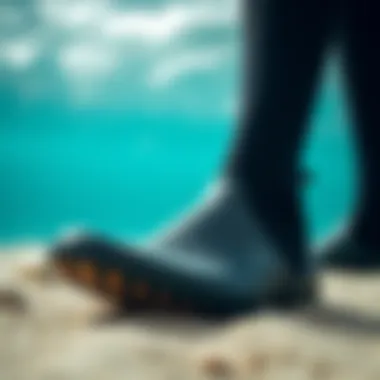
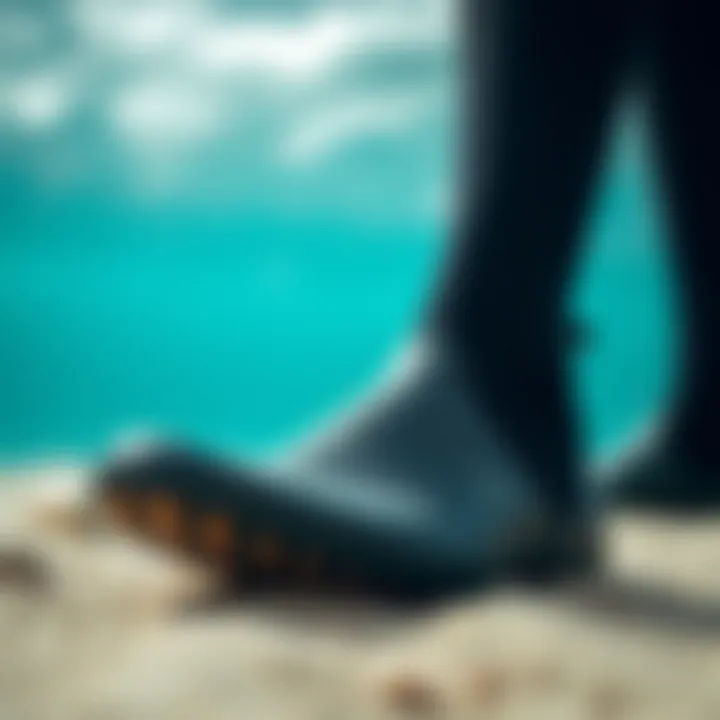
Understanding the properties and benefits of these materials is key to ensuring you're well-equipped for any adventure on the water.
Factors to Consider When Choosing Wetsuit Shoes
Choosing the right wetsuit shoes is more than just a matter of picking a pair that looks nice. A thorough understanding of the factors involved can make or break your experience in the water. Wetsuit shoes are designed not just to keep your feet warm but also to ensure comfort and safety during various watersport activities. Let’s delve deeper into the critical elements to keep in mind as you navigate through your options.
Fit and Comfort
Getting the fit right is perhaps the most vital factor when it comes to selecting wetsuit shoes. A snug fit prevents water from seeping in, which keeps your feet warmer and more comfortable.
When trying on shoes, consider how they feel both when you first put them on and after you've been moving around in them for a bit. Look for flexibility—your toes should have some space to wiggle without the shoe feeling too loose. Additionally, keep in mind:
- The shoe should fit tightly but not painfully.
- Thick neoprene can add warmth, but if too tight, it can restrict circulation, leading to cold feet.
- Many shoes have internal flat seams that minimize irritation, so check for comfort on this front as well.
Maintaining an ideal level of comfort allows you to focus on your activity, whether that's riding waves or paddling across a calm lake.
Sizing Standards
Sizing can be a tricky terrain. Unlike regular shoes, wetsuit shoes may have their own sizing charts and philosophies. It's not uncommon for one brand's size to differ from another's, so here are a few tips:
- Consult Size Charts: Each brand usually provides a sizing chart. Make sure to compare your foot measurements with their specifications.
- Account for Thickness: If you're planning to wear thicker socks or extra layers for insulation, consider going up half a size.
- Take Into Account Activity Level: Some sports may require additional maneuverability—be it a looser fit for kitesurfing or a more snug fit for paddleboarding.
Ultimately, the goal is to select a size that optimally balances snugness and flexibility. A badly fitted shoe can ruin your day on the water, so take the time to figure those numbers out.
Intended Use
Different watersports have diverse requirements. Whether you're surfing, kitesurfing, or paddleboarding, choosing the right wetsuit shoe tailored to your specific activity can significantly enhance your experience.
- Surfing: Look for shoes with thinner soles to better feel the board. Grip and agility are key.
- Kitesurfing: Here, secure fit matters as you’ll want to avoid your shoes slipping off during jumps or maneuvers.
- Paddleboarding: A more cushioned shoe can help keep your feet comfortable for longer durations.
It's important to think about how often you’ll be in the water and the conditions you’ll face. Check if the shoes are water-resistant or if they dry quickly; these factors can also influence your choice. This consideration not only affects your comfort but can also make a difference in your overall performance during your activity.
"Understanding the nuances in fit, size, and specific use can be the difference between a great day out on the water and an uncomfortable one."
In summary, the choices you make about these crucial factors will set the tone for your entire watersport experience. Prioritizing fit, being aware of sizing discrepancies, and considering the intended use of the shoes will help you make an informed decision, ensuring that you have a comfortable and enjoyable time on the water.
Top Brands of Wetsuit Shoes
When selecting wetsuit shoes, the brands you consider can make all the difference. The world of watersport gear has several key players, each offering unique features and innovations that cater to different needs. Understanding the top brands is essential for anyone looking to optimize their watersport experience. They often provide reliability, diverse options, and customer support, ensuring that you feel confident in your purchase.
Familiarizing yourself with top brands helps you identify standout models that boast superior performance, durability, and comfort. Additionally, insights into these brands often reveal trends and technologies pioneering the industry.
Brand A
Product Range
Brand A offers an extensive product range that caters to various watersports enthusiasts. This selection encompasses styles from full-bottomed booties to ankle-high designs, allowing users to pick based on their preferred level of warmth, flexibility, and protection. The key characteristic of Brand A's product range is its focus on innovation—many models incorporate advanced materials designed to maximize thermal insulation while retaining adaptability.
A unique feature here is the split toe design in some of their models, which enhances balance and board feel when surfing. However, some users find that this design may take time to get used to.
User Reviews
Regarding user reviews, Brand A typically garners positive feedback, with many customers praising the comfort and fit of their shoes. Reviewers frequently highlight the durability of the shoes, noting that they withstand harsh conditions, whether in rocky reefs or tranquil bays.
Although the brand seems to have earned a good reputation, a common downside noted in the reviews is that the sizes can sometimes run small, prompting recommendations to buy a size up. This aspect demands attention when making a purchase decision.
Price Range
Brand A is known for its mid-range to high-priced soles, making footwear accessible for both casual users and serious water athletes. The price range reflects the quality of materials and protection offered, with prices typically hovering between $50 and $150 depending on the model and features.
Visibly, models priced at the higher end come with added features like better thermal insulation or extra grip. However, the variance in pricing could mean that some individuals may find it a bit pricey, especially for those just starting.
Brand B
Product Range
Brand B emphasizes product range diversity by offering shoes tailored explicitly for specific activities like kitesurfing, paddleboarding, and surfing. Their models often include unique features aimed at maximizing performance. The signature aspect of their product range includes lightweight and flexible designs that provide a natural feel for the rider.
For instance, several shoes in their lineup integrate advanced drainage systems allowing water to escape efficiently, keeping the weight down. However, this might also mean reduced thermal protection in cooler waters.
User Reviews
The user reviews for Brand B tend to highlight the brand's exceptional comfort and ankle protection. Many users mention feeling confident while riding, attributing this to the shoes' snug fit and excellent grip.
Nevertheless, some consumers express concerns about the longevity of certain models. Reports of stitching coming undone after continued use indicate a need for potential improvement in manufacturing.
Price Range
Brand B's price range varies widely, sitting comfortably between $40 and $120, making it accessible for newcomers as well as seasoned surfers. The budget-friendly options do not skimp on essential features, offering great value for the price.
However, it's worth noting that the lowest-priced models may not hold up as well to long-term use, which could deter committed watersport enthusiasts from choosing them.
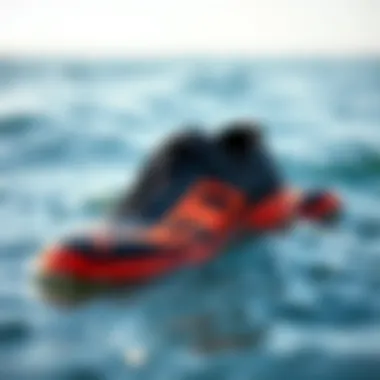
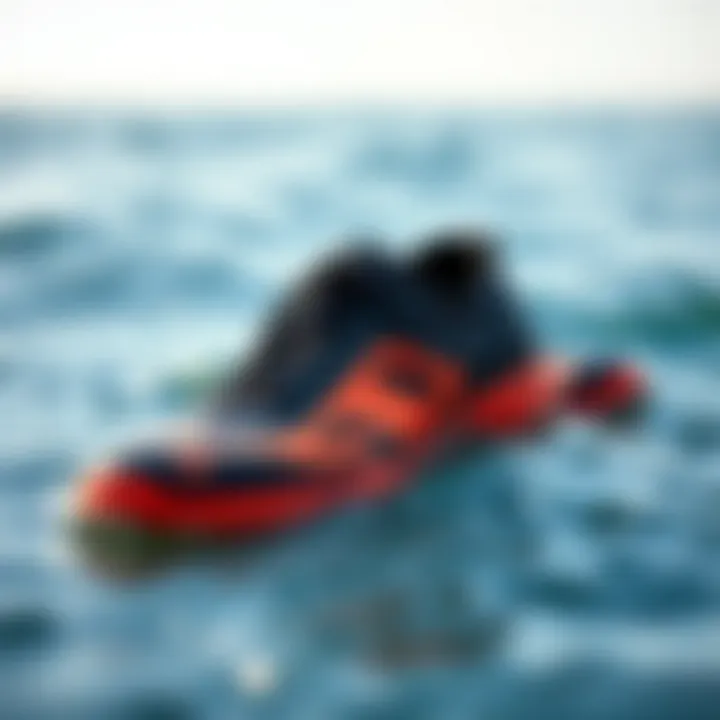
Brand
Product Range
Brand C takes pride in an innovative product range that combines eco-conscious materials with advanced technology. Their range often includes boots made from recycled resources without compromising performance. A standout characteristic is their use of unique rubber compounds—these provide both flexibility and durability, essential for navigating rugged environments.
Notably, some models come equipped with specialized treads designed to enhance grip on various surfaces. However, this innovation might lead to a marginal increase in price.
User Reviews
The user reviews for Brand C frequently emphasize sustainability as a significant selling point. Many users resonate with the unparalleled eco-friendliness of their shoes, alongside frequently lauding their comfort and fit. Reviewers tend to appreciate the unique design aesthetic that distinguishes Brand C from competitors.
Conversely, some feedback indicates that while the shoes are comfortable, they might not provide the same level of longevity as some traditional models, raising questions on their long-term value.
Price Range
The price range for Brand C tends to be on the higher side, often falling between $80 and $180. While this can be deemed pricey, it reflects the commitment to using sustainably sourced materials. This aspect appeals to environmentally conscious consumers, though some individuals may struggle to justify the expense.
"Selecting a wetsuit shoe from a recognized brand often enhances the likelihood of satisfaction and performance, as established brands invest significantly in research and development."
Review of the Best Wetsuit Shoes
When it comes to selecting the best wetsuit shoes, there's no understating the importance of comprehensive reviews. These assessments are not merely a collection of user opinions but a vital part of the decision-making process for anyone engaged in aquatic sports. With the myriad of options available on the market today, it can be downright bewildering to pin down the right pair that will meet your specific needs. This section serves to simplify that process, providing an overview of performance, real-life user experiences, and comparative ratings that give potential buyers clarity and confidence.
Performance Analysis
The performance of wetsuit shoes is paramount since they directly impact your experience in the water. To truly gauge a shoe's effectiveness, one must consider various attributes such as insulation, comfort, and flexibility.
- Insulation: A shoes’ ability to retain warmth is crucial, particularly in colder waters. Brands employing high-quality neoprene tend to excel in this area. For instance, shoes that are 5mm thick can keep the chill at bay longer than their thinner counterparts.
- Comfort: If your shoes pinch or create hotspots, it won’t matter how well they perform otherwise. The right pair should feel like a second skin, allowing for both movement and ease.
- Flexibility and fit: Flexibility is key for activities like surfing or paddleboarding, where precise foot placement matters. A shoe that bends easily at the right points significantly enhances maneuverability.
Potential buyers should look for reviews that focus specifically on these aspects, noting how a particular shoe performed in various conditions.
Customer Feedback
The voices of customers play a pivotal role in understanding the real-world applications of wetsuit shoes. Online platforms like Reddit, Facebook, and specialized forums are treasure troves of information.
- Quality Assurance: User reviews often highlight specific experiences with durability and waterproof qualities. Many users mention how quickly some shoes wear out, while others maintain their integrity even after several seasons.
"A good pair of wetsuit shoes should feel like they can take a beating, and many don't hold up as they should against surf and sand," notes a user on Reddit.
- Noise Levels: While not often discussed, some users comment on how shoes create noise while walking on the shore. This can be a bothersome aspect for some.
- Brand Reputation: Some brands consistently receive high marks across boards for service and product reliability. Customer feedback can reveal insights about warranty expectations and brand responsiveness that are crucial for making a choice.
Comparative Rating
Bringing data together from various sources creates a clearer picture of which wetsuit shoes stand atop the pile. Ratings derived from both performance testing and user feedback allow for a comparative analysis that can guide buyers effectively.
- Score Systems: Many platforms utilize a star rating system, which can aid quick evaluations. Each shoe can be rated based on categories like warmth, durability, and flexibility.
- In-Depth Comparisons: It is beneficial to look at head-to-head comparisons that synthesize key attributes. For example, a side-by-side comparison of two brands might reveal that while Brand X excels in insulation, Brand Y offers superior traction on wet surfaces.
In summary, the performance analysis, customer feedback, and comparative ratings provide an essential foundation for any purchase decision regarding wetsuit shoes. Understanding these factors equips aspiring surfers, paddleboarders, and kitesurfers alike with the knowledge to select a product that meets both performance demands and individual comfort needs.
Specific Recommendations for Different Watersports
When it comes to choosing the right wetsuit shoes, watersport enthusiasts know that each activity demands its own set of requirements. Selecting the appropriate footwear can significantly enhance performance and comfort, whether you're riding the waves, flying over water, or gliding on a paddleboard. This section dives into the specific recommendations for surfing, kitesurfing, and paddleboarding, highlighting essential considerations that cater to the unique needs of each sport.
Surfing
Surfing is a dance between rider and ocean. The right wetsuit shoes can make or break a session, influencing not just comfort but also performance in the water. When looking for shoes tailored for surfing, consider the following elements:
- Fit: Sneakers should fit snugly but not be too tight. Loose shoes can come off and ruin your ride.
- Material: Look for shoes made with high-quality neoprene to ensure warmth without bulk. Avoid any heavy soles that can weigh you down when paddling out.
- Traction: A reliable grip on the surfboard is crucial. Shoes featuring textured rubber soles help prevent slipping and enhance your connection to the board, a must when catching those crucial waves.
- Flexibility: A shoe that bends easily at the foot's arch without losing shape will provide better comfort and reduce fatigue.
After considering these aspects, brands such as Roxy and O'Neill are often favored among surfers for their blends of style and functionality, with a variety of models to suit diverse tastes and needs.
It’s all about finding that balance between protection and performance; the perfect pair of shoes can amplify your surfing experience like a flawless wave.
Kitesurfing
Kitesurfing presents unique challenges, integrating aspects of both surfing and wind power. The right wetsuit shoes can give you the edge you need while battling the elements. When selecting footwear for kitesurfing, here are key points to ponder:
- Support: Your ankles should feel secure, especially when jumping off the water. Boots with a high shaft can provide additional ankle support against sprains, adding confidence when taking on larger waves.
- Closure Systems: Look out for shoes with strong fastening systems that keep them snug on your feet, such as Velcro straps or laces.
- Drainage: Water will inevitably enter your shoes, so draining the water quickly can help keep you light on your feet. Opt for shoes designed with drainage holes or mesh openings for better performance.
- Cushioning: Kitesurfing often involves hard landings; therefore, shoes with adequate cushioning in the soles can absorb impact and protect your feet.
Brands like Mystic and Ion have developed specially tailored footwear to meet the demands of the sport, combining technology with user feedback to create viable kitesurfing options.
Paddleboarding
When it comes to paddleboarding, comfort and versatility reign supreme. Because this activity can vary dramatically in terrain—ranging from sandy shores to rocky inlets—selecting the right shoes is paramount. Consider the following:
- Versatile Use: Shoes with decent traction but more flexible soles will give you room to adapt in different conditions, essential for stepping on the board or the shoreline.
- Quick Drying: Choose materials that dry fast; a wet shoe can be a nuisance during trail outings or longer excursions on the water.
- Breathability: Your feet can get quite hot, especially in warmer climates. Breathable materials such as mesh enhance ventilation and comfort.
- Ease of Use: Look for slip-on designs for quick transitions from land to water, making your adventures smooth and effortless.
Brands like Olukai and Merrell are popular within the paddleboarding community for their comfort, longevity, and commitment to wet conditions. With options designed for water sports in mind, you're bound to find something that suits your needs perfectly.
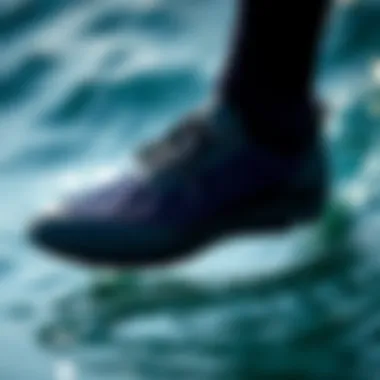
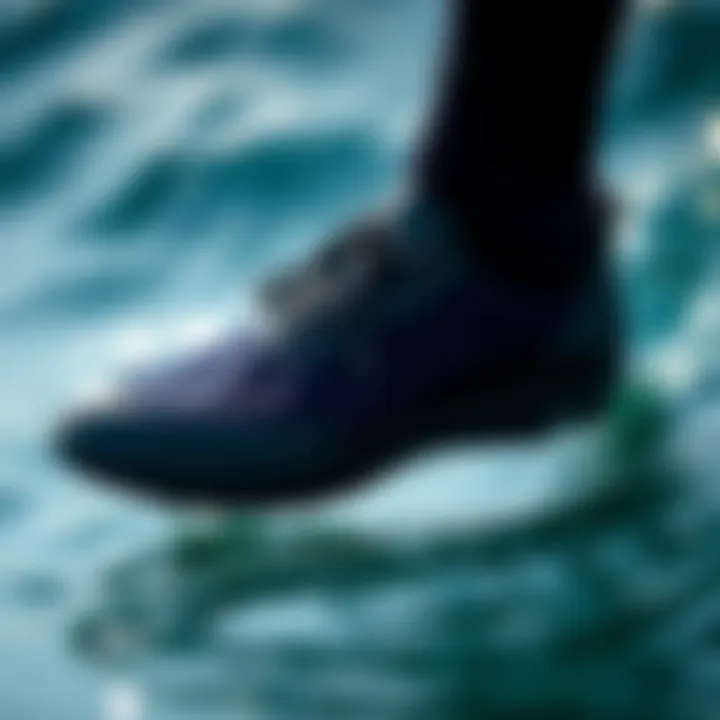
Maintenance Tips for Wetsuit Shoes
Maintaining your wetsuit shoes is key if you want them to last season after season. These shoes, much like any other piece of gear, are subjected to wear and tear. Saltwater, sand, and other environmental factors can conspire to hasten their deterioration. Hence, taking a bit of time to care for them properly can yield both comfort and durability in the long run.
Investing in good maintenance practices not only prolongs the life of the shoes but also enhances your on-water experience. A clean and well-maintained wetsuit shoe can offer better performance, improved fit, and superior protection against the outdoor elements.
Cleaning Procedures
When it comes to cleaning your wetsuit shoes, a straightforward routine can make all the difference. Here’s how to go about it:
- Rinse Immediately: After each use, especially if you’ve been in the ocean, rinse your shoes with fresh water. Saltwater can cause degradation, making them more brittle with time.
- Use Mild Soap: Occasionally, apply a mild soap designed for neoprene. Avoid harsh detergents that can ruin the material. A soft sponge or cloth works best to remove dirt without damaging the surface.
- Ensure Thorough Rinsing: After scrubbing, make sure to rinse thoroughly to get rid of any soap residue, which might cause irritation during usage.
- Drying: Let them air dry in a shaded area, away from direct sunlight to prevent the material from breaking down. Stuffing them with newspaper can also help them retain shape and absorb excess moisture.
By developing a regular cleaning routine, you can eliminate stubborn buildup and avoid the unfortunate fate of smelly wetsuit shoes.
Storage Recommendations
Proper storage is just as critical as cleaning. If you toss them haphazardly into a bag or a damp corner of your garage, you may find your trusty shoes are not so trusty any longer. Here are some tips for optimal storage:
- Cool, Dry Place: Store them in a cool and dry environment. Humidity can lead to mold growth, compromising both hygiene and structural integrity.
- Avoid Folding: Don’t fold or bend your shoes when storing them. Instead, keep them flat or hang them if possible. This helps preserve their shape and fit.
- Use a Mesh Bag: A breathable mesh bag can be a good option for storage. It allows air circulation, preventing moisture buildup around the material.
- Check Periodically: Every now and then, take a moment to check your shoes. Give them a little sniff to ensure they’re not harboring unpleasant odors.
Incorporating these maintenance tips can extend the life of your wetsuit shoes considerably. By focusing on cleanliness and proper storage, you’ll maintain the quality, comfort, and functionality of your footwear, ensuring enjoyable sessions on the water.
Environmental Considerations in Wetsuit Shoe Manufacturing
As outdoor enthusiasts increasingly prioritize sustainability, the way wetsuit shoes are manufactured is coming under the spotlight. This section of our guide reveals the environmental implications associated with the production of wetsuit shoes, tackling how eco-conscious decisions can not only benefit the user but also contribute positively to our planet's health. It’s crucial for surfers, paddleboarders, kitesurfers and instructors to understand how their gear impacts the environment, particularly in a world where clean oceans and lakes are foundational to their activities.
Sustainable Materials
When picking out wetsuit shoes, the choice of materials can make all the difference. Traditional wetsuit shoes often use neoprene, which is derived from petroleum. While effective, its environmental footprint is significant, leading many brands to seek alternatives that reduce harm to the planet.
Sustainable materials like natural rubber, organic cotton, and even biodegradable options have emerged as viable substitutes. Not only do these alternatives decrease carbon emissions during production, they also lessen the likelihood of pollution in our water bodies. Plus, when these products reach the end of their lifecycle, they decompose much more cleanly compared to their synthetic counterparts.
A heightened demand for such materials is pushing manufacturers to be more transparent about their processes, encouraging consumers to ask questions and hold brands accountable. This change can ripple through the industry, potentially leading to an eco-conscious wave where every purchase contributes to a healthier environment.
"Making informed choices about your gear not only enhances your enjoyment of the watersports you love, but also fosters a movement towards a more sustainable future."
Eco-Friendly Brands
The market is gradually teeming with brands that put sustainability at the forefront of their operations. These companies employ eco-friendly practices not just in materials, but across the entire manufacturing process.
Brands like Xcel and Rip Curl have invested in developing shoes made from recycled or natural materials, showcasing that performance doesn't have to suffer at the expense of the environment. They often partake in initiatives that support ocean cleanup efforts and contribute funds to environmental organizations. This commitment goes beyond mere marketing; it reflects a genuine effort to align their business goals with the health of marine ecosystems.
When purchasing wetsuit shoes, consider taking that extra moment to research. Look for certifications indicating sustainable practices, and don’t shy away from supporting those brands actively striving to make a difference. It's the small choices made on the consumer end that can drive meaningful change in the industry.
Future Trends in Wetsuit Shoe Development
As the demand for wetsuit shoes grows among watersport enthusiasts, manufacturers are under pressure to innovate and adapt. This section looks at the significance of future trends in wetsuit shoe development. Understanding these trends is critical for anyone interested in buying or using wetsuit shoes, including surfers, paddleboarders, kitesurfers, and instructors.
Technological Advancements
Recent years have witnessed a surge in technological advancements in the fabrication of wetsuit shoes. One of the frontrunners in these innovations is the integration of smart materials that can alter warmth levels according to the surrounding conditions—imagine slipping on a shoe that adjusts its insulation as the water temperature fluctuates. This could potentially eliminate the discomfort of cold feet, a common plight for many athletes.
In addition, 3D printing technology is making waves. By employing this cutting-edge technique, brands can create more customized fits tailored to unique foot shapes. This personalization can enhance comfort and performance. Such shifts not only resonate with the needs of serious athletes but also appeal to casual users looking for a cozy fit.
Moreover, sustainable practices are playing a pivotal role. With the consciousness about environmental challenges, manufacturers are starting to implement eco-friendly materials in their designs. Natural rubber and plant-based neoprene alternatives are cropping up, which helps in reducing the carbon footprint associated with production.
Consumer Expectations
With change in technology comes evolving consumer expectations. Today's users are not just looking for a product that keeps their feet dry. They want comfort, durability, and performance wrapped up in an environmentally-friendly package. According to recent surveys, almost 70% of watersport participants have expressed a preference for products that support sustainability.
Moreover, customers are keen on functionality. They seek shoes that can transition seamlessly from watersports to casual wear. This expectation poses a challenge for engineers and designers alike, pushing them to create versatile products without compromising performance. Features like improved drainage systems and flexible materials are becoming commonplace as a response to these desires.
It's also vital for brands to maintain open lines of communication with their customers. They need to capture real-time feedback to adapt and innovate continually. Social media platforms, like Reddit and Facebook, have become essential resources for gauging consumer sentiment. Brands that actively engage and take feedback seriously tend to foster brand loyalty and trust.
In the rapidly evolving market, staying ahead of consumer expectations is just as important as delivering high-quality products.
In summary, the trends in wetsuit shoe development are fascinating and indicate an exciting future for both the industry and the consumers. By focusing on technological advancements and clearly understanding consumer expectations, companies can pave the way for the next generation of wetsuit shoes that cater to the needs of a diverse and growing audience.
Closure on Optimal Wetsuit Shoes
By now, it should be glaringly evident how essential it is to choose the right wetsuit shoes for your activities on the water. Selecting optimal footwear not only contributes to comfort but also enhances performance across various watersports. Whether you’re surfing gnarly waves, navigating through an exhilarating paddleboarding session, or catching the wind on your kite, your feet deserve the right kind of protection.
Investing in quality wetsuit shoes can make a world of difference. These shoes are specifically designed to provide warmth, grip, and support. Imagine slipping into a pair that's tailored for your foot shape – snug without being restrictive, allowing you to perform at your best without the nagging discomfort that can arise from poorly fitted gear.
Specific Benefits of Optimal Wetsuit Shoes:
- Insulation: Effective wetsuit shoes keep the chill at bay, helping you maintain body warmth in cooler waters. Remember, it’s not just about comfort; it’s about staying safe and alert during your activities.
- Traction and Stability: A solid grip on slippery surfaces can give you an edge, especially in sports like surfing or paddleboarding. High-quality outsoles can make all the difference between staying upright or taking an unexpected plunge.
- Protection: The elements can be unforgiving. Sharp rocks, coral, and other hazards can easily injure unprotected feet. Wetsuit shoes ensure that your feet are cushioned against these dangers, allowing you to fully enjoy your aquatic adventures.
Considerations to Keep in Mind:
- Material Selection: Neoprene is a common choice for its insulation properties but pay attention to other materials as they can enhance flexibility and comfort.
- Fit: Shoes that are too loose can cause blisters and discomfort. On the other hand, an overly tight fit can impede circulation. Finding that just right fit is crucial.
- Brand Reputation: When evaluating options, check user reviews and performance reports from trusted sources. Some brands are consistently favored within the watersports community, indicating reliability.
Ultimately, the best wetsuit shoes won't just protect your feet; they will elevate your performance and enjoyment on the water. As you venture into your next watersport experience, reflect on the importance of well-chosen footwear. It might seem trivial at first glance, but as the adage goes, "Walk a mile in someone’s shoes" – or in this case, surf, paddle, or kite in them. Your feet are the unsung heroes of the journey, and with the right shoes, you'll navigate effortlessly across rivers, lakes, and oceans.
"The right gear can change everything, elevating your performance from ordinary to extraordinary."
In summary, prioritizing the selection of optimal wetsuit shoes can significantly affect your overall experience, making those waves, currents, and breezes far more manageable and enjoyable.



